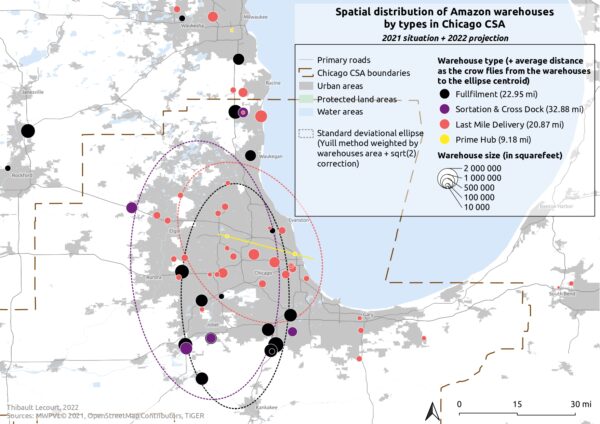
Un article de Matthieu Schorung vient de paraître dans la revue Journal of Transport and Land Use, accessible par le lien suivant : https://jtlu.org/index.php/jtlu/article/view/2438
Schorung, M., Lecourt, T., & Dablanc , L. (2024). Assessing the spatial footprint of e-commerce logistics differentiating the types of warehouses: The case of Amazon in the United States. Journal of Transport and Land Use, 17(1), 647–674. https://doi.org/10.5198/jtlu.2024.2438
Résumé :
E-commerce is simultaneously creating a new retail landscape through digitalization and new consumption and distribution practices and a new freight landscape in terms of the structuring of demand, the location characteristics of warehouses and distribution centers, and the handling of the last-mile segment in dense urban areas. Amazon represents all these developments in retail and e-commerce, being a dominant player in the e-commerce sector. This research, therefore, focuses on the evolution of Amazon’s logistics system, and particularly the geography of Amazon’s warehouses, marked by an expansion of the spatial footprint of the warehouses and by a functional specialization of its logistics system. From the analysis of Amazon’s logistics system, we understand how strong the spatial footprint of e-commerce is and we can confirm some of the major processes affecting the e-commerce sector. With the empirical spatial analysis, we identify through cartographic representations several spatial logics of Amazon’s logistics system: (i) a dual spatial rationale of networking and concentration of logistics warehouses, with the development of clusters of warehouses around major transport infrastructures and the creation of a more or less fine network of warehouses, particularly in urban areas; (ii) a dual spatial rationale that focuses both on the outskirts of metropolitan areas and on dense urban centers; (iii) the emergence of regionalized logistics strategies and differentiated spatial patterns regarding the type of logistics facility.



